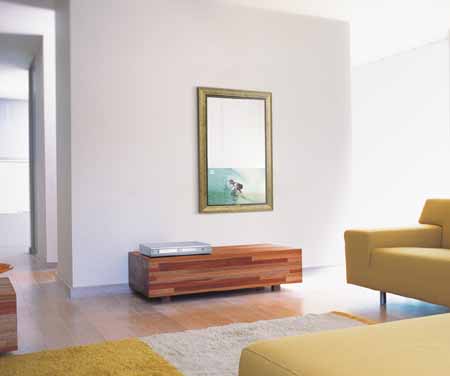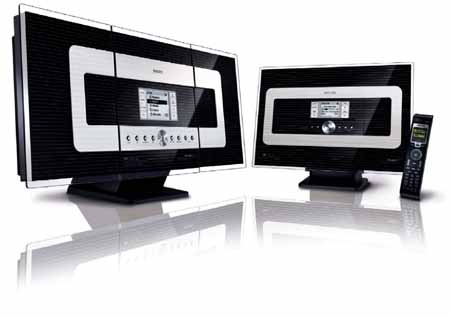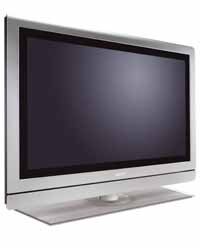2005 CES: Day 3
But sometimes we're offered a glimpse of things to come which we can talk about. In yesterday's posting, I mentioned the fine work that the folks at Audyssey Laboratories are doing in the way of room correction and equalization. Although the first iteration of this technology is already available in Denon's flagship receiver (AVR-5805), it's soon to be coming to a retail store near you in less formidable (and less expensive) pieces of gear; and, when incorporated into standard Home Theater in a Box (HTiB) systems, it promises to be much, much less expensive (although not as configurable nor as powerful). And then there was that very interesting demonstration of Audyssey's correction technology applied to, of all things, headphones.
Wireless A/V and Flat Sound
But Audyssey wasn't the only peak at the future we were privy to. After one of those take-with-a-grain-of-salt "you've got to see this" e-mails from a friendly PR person, I went to see a wireless A/V technology demonstration conducted by Adimos, a provider of semiconductors for wireless home networking. The prototype product Adimos dangled before my eyes was a high-quality wireless A/V transmission system capable of delivering high-definition video up to around 160 feet - depending on the physical situation. Much like other wireless A/V systems, the primary demonstration setup consisted of a transmission box that was hooked up to the A/V output of a DVD player (or other video device) and sent the signal through the air to the companion receiver connected to a television. The A/V quality was extremely good, especially compared with other wireless systems currently on the market, and Adimos claimed it had a very high level of security to avoid the possibility of neighbors "tuning in" to your video. In another room, there were several simultaneous transmissions of HD signals with no apparent interference. Finally, Adimos showed a prototype portable wireless LCD TV with an integrated Adimos wireless receiver. I was able to carry at least a hundred feet down the hotel's hallway before the signal was lost. Since Adimos doesn't intend on building product themselves - they want to license the technology to current manufacturers - you probably won't see or hear the Adimos name in conjunction with future wireless products. But if you start hearing about a wireless product with exceptional A/V quality, it might just have Adimos inside.
Another new technology to which we're sworn to secrecy involves a flat panel speaker design that's as revolutionary as it is great sounding, and it has an exceptionally high number of potential applications. We hope to have more information in the coming months. This promises to be incredibly hot and will change the way you look at sound. We'll keep you posted.
Kitchen Magician

Other products we saw were either available or soon will be. Beyond, for example, demonstrated a new version of their iCEBOX Countertop CT04 Touchscreen Monitor/TV/FM Radio/DVD/CD player ($1,799). The counter-top "kitchen computer", keyboard, and remote control are splash-proof; and they not only provide entertainment and Internet access in your kitchen (think recipes, movies, or music), the system also communicates with other Beyond appliances such as a new Westinghouse microwave oven ($149), coffee maker ($99), and bread maker ($149). The microwave oven comes with a barcode reader that, after you scan the barcode on a food box, will automatically set itself for best cooking time and power level based on preprogrammed preparation information or info accessed via the Internet. This is yet another glimpse of the connected home in which you, or at least your children, will be inhabiting in the future.

TV, TV on the Wall, Who's the Coolest of them All?
The Philips booth is always a good place to see something cool, whether it's a small handheld gadget or a bigger innovation. This year was no exception. Philips demonstrated a 30" model of their MiraVision Mirror TV. Two versions will be available within the next three months. The first is a horizontal configuration in which the TV screen and the mirror are the same size allowing you to choose to see either the mirror or the TV. The vertical configuration can be used as a full-length mirror or as a mirror on top with a TV screen on the bottom. Pricing is expected to vary from $1,999 to $3,999 depending on the configuration.

More likely to be found in your home in the near future is Philips' new RC9800i touchscreen remote control. The RC9800i is both less and more sophisticated than many of the well known Philips Pronto remotes because it has Wi-Fi communication capabilities (including the ability to receive Electronic Program Guide (EPG) and operating software updates via a wireless home network connected to the Internet) as access to content on your PC. The RC9800i is less configurable overall than a Pronto - it uses an "intelligent" setup wizard and Activity-Based Control to create individual component commands and commonly used macros - but that's probably a good thing for the do-it-yourself non-programming home user Philips is targeting with this $499 remote.

Another Philips product aimed at the self-installer is the new Wireless Music Center. The new system has the ability to convert audio CDs into MP3 music files, store them on a 40 GB hard disk (that's enough for up to 750 music CDs), and wirelessly stream music to up to five Wireless Music Stations simultaneously, anywhere in the home. The music streams can be the same in every room, five different selections, or any mix in between. Because Wi-Fi networking capability (802.11g) is built in, you don't need to have a wireless home computer network for this system to use; although it can also access music files on PCs if you have a wireless home network. Both the server and the stations include integrated flat-panel speakers, so there's nothing else extra to buy (other than CDs). Coming in April, the Wireless Music Center will be $999.

Finally, Philips gave us a look at a new 32" LCD TV with much improved motion sharpness that comes from, according to Philips, installing more light sources and adding intelligence to a key component of an LCD TV, the backlight module. Light leakage between pixel elements is also reduced leading to increased contrast and a wide viewing angle. Other flat-panel sets from Philips feature Ambilight 2 backlighting that can be set to track with the predominant colors in the on-screen image. Philips maintains that this helps reduce eye fatigue, makes the colors look more accurate, and give the TV screen the appearance of being larger than it really is.
And then there was the difficult task of attending those pesky cocktail parties...
- Log in or register to post comments

























































